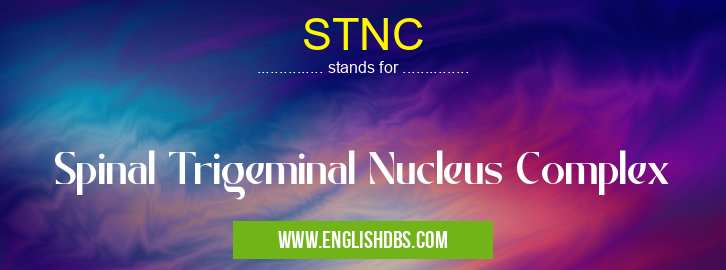What does STNC mean in PHYSIOLOGY
Spinal Trigeminal Nucleus Complex (STNC) is a network of neurons located in the brainstem, specifically in the medulla oblongata. It plays a crucial role in the processing of sensory information from the face and mouth.

STNC meaning in Physiology in Medical
STNC mostly used in an acronym Physiology in Category Medical that means Spinal Trigeminal Nucleus Complex
Shorthand: STNC,
Full Form: Spinal Trigeminal Nucleus Complex
For more information of "Spinal Trigeminal Nucleus Complex", see the section below.
» Medical » Physiology
STNC Meaning in MEDICAL
The STNC is involved in various functions related to sensory processing, including:
- Pain perception: It receives and processes pain signals from the face, including the trigeminal nerve, which innervates the skin of the face and the mucous membranes of the mouth and nose.
- Tactile sensation: It also processes tactile sensations, such as touch and pressure, from the face.
- Temperature perception: The STNC plays a role in detecting temperature changes on the face.
- Proprioception: It contributes to the sense of position and movement of the face.
STNC Full Form
The full form of STNC is Spinal Trigeminal Nucleus Complex.
What does STNC Stand for
STNC stands for Spinal Trigeminal Nucleus Complex, which refers to the group of neurons in the medulla oblongata responsible for processing sensory information from the face and mouth.
Essential Questions and Answers on Spinal Trigeminal Nucleus Complex in "MEDICAL»PHYSIOLOGY"
What is the Spinal Trigeminal Nucleus Complex (STNC)?
The Spinal Trigeminal Nucleus Complex (STNC) is a group of neurons located in the brainstem that receives sensory information from the face and oral cavity. It is involved in the processing of pain, temperature, and touch sensations.
What are the main functions of the STNC?
The STNC plays a crucial role in transmitting and processing sensory information from the face and oral cavity. It is involved in the following functions:
- Detecting and transmitting pain, temperature, and touch sensations
- Modulating pain signals
- Reflexive responses to pain and touch
What conditions can affect the STNC? A: Various conditions can affect the function of the STNC, including: Trigeminal neuralgi
Various conditions can affect the function of the STNC, including:
- Trigeminal neuralgia: A chronic pain condition that affects the trigeminal nerve, which transmits sensory information from the face to the STNC
- Multiple sclerosis: A neurological condition that can damage the STNC and other parts of the nervous system
- Stroke: A disruption of blood flow to the brain that can damage the STNC
How is the STNC studied?
The STNC can be studied using various techniques, including:
- Neuroimaging: Techniques such as magnetic resonance imaging (MRI) and functional magnetic resonance imaging (fMRI) can provide images of the STNC and assess its function
- Electrophysiology: Recording electrical activity from the STNC can help understand its role in sensory processing
- Animal models: Studying the STNC in animal models can provide insights into its function and potential treatments for related conditions
Final Words: The STNC is a vital component of the nervous system, responsible for processing sensory information from the face and mouth. It plays a crucial role in pain perception, tactile sensation, temperature detection, and proprioception. Understanding the STNC's functions is essential for comprehending the complex mechanisms involved in sensory processing in the body.
